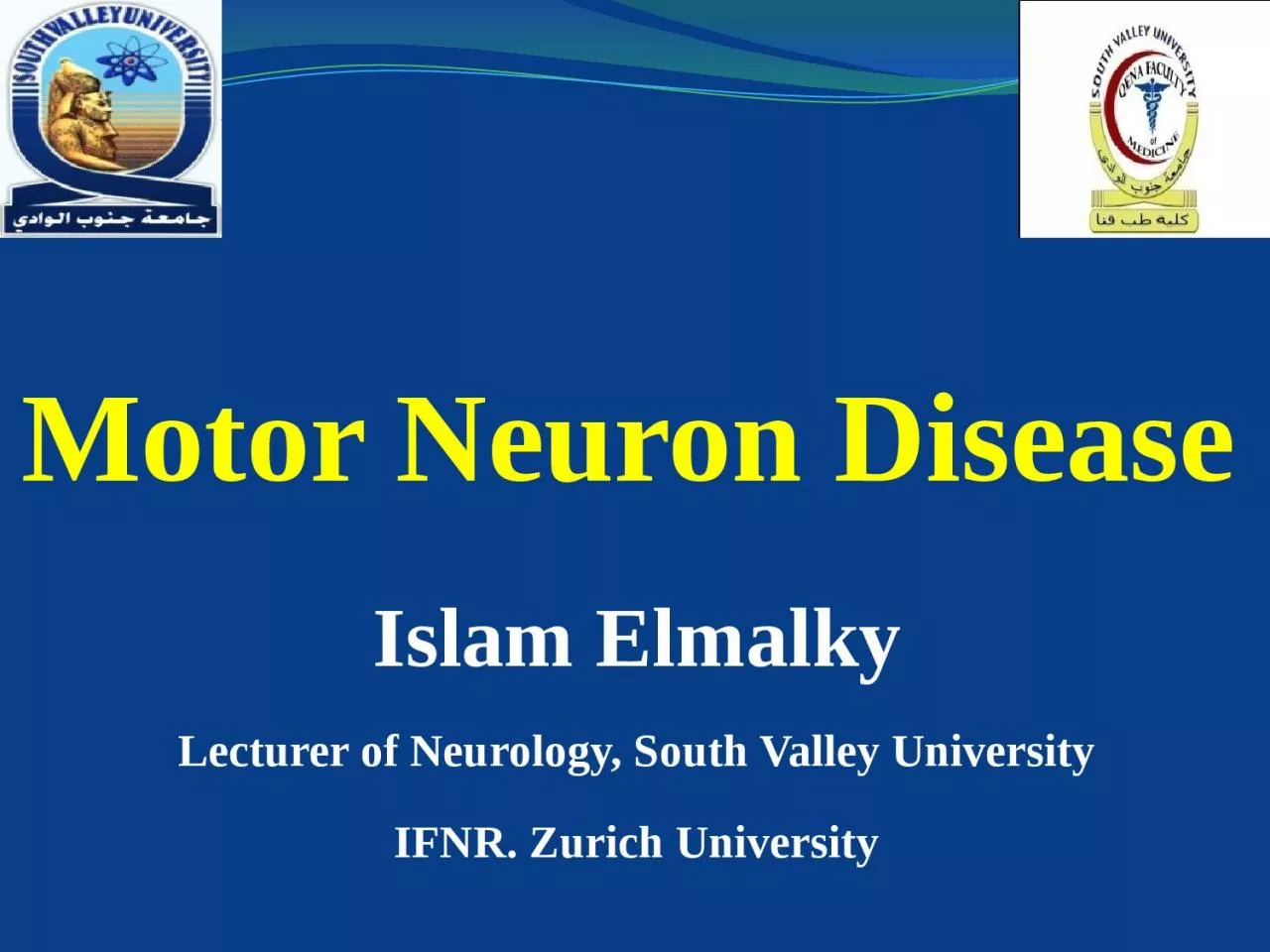

Elmalky Lecturer of Neurology South Valley University IFNR Zurich University These disorders are characterized by selective loss of function of the Lower andor upper motor neurons due to selective degenerative changes which involve ID: 997870
Download Presentation The PPT/PDF document "Motor Neuron Disease Islam" is the property of its rightful owner. Permission is granted to download and print the materials on this web site for personal, non-commercial use only, and to display it on your personal computer provided you do not modify the materials and that you retain all copyright notices contained in the materials. By downloading content from our website, you accept the terms of this agreement.
1. Motor Neuron DiseaseIslam ElmalkyLecturer of Neurology, South Valley UniversityIFNR. Zurich University
2. These disorders are characterized by selective loss of function of the Lower and\or upper motor neurons due to selective degenerative changes which involve; → The anterior horn cells of the spinal cord, → The corticospinal tracts and the motor nuclei of the brain stem
3.
4. Classification of Motor neuron diseases 1-Pure upper motor neuron involvement Hereditary spastic paraplegia1ry lateral sclerosisPseudobulbar palsy 2-Pure lower motor neuron involvementProgressive muscular palsy Spinal muscular atrophiesProgressive bulbar palsy (hereditary bulbar palsy)Postpolio syndrome
5. 3-Combind upper and lower neuron involvement *(Amyotrophic lateral sclerosis)
6. *Characters: -Autosomal dominant or recessive inheritance -Age of onset may be early before 20 years but not later than 40 years. -Gradual onset, progressive course -There is degeneration of the crossed pyramidal tract -The dorsal root ganglia, posterior roots & the peripheral nerves are spared .1-Hereditary spastic paraplegia
7. *Clinically: -Weakness of both LL of UMN features -Difficult spastic gait, tendency to trip. -Hyperreflexia, clonus in both LL -Stiffness and spasticity of both legs -Bilateral extensor planter reflex -Upper limbs: may be slightly effected in the form of *brisky reflexes ,mild weakness, Stiff finger -No sensory level -No sphinecteric disturbances NB -Deep sensory impairment (vibration, position) and urgency may be present only in 10% of patients
8. 2-1ry lateral sclerosis (PLS)Represent (1-3%)of All MNDAge:-usually after 20 Spasticity , clonus,hyperflexia,extensor planters and pyramidal patterns of weakness in both LL (mainly) .-Psedobulbar symptoms.(dysarthria, dysphagia, and emotional lability (fits of laughing or crying, termed pseudobulbar affect)
9. - The absence of diffuse fasciculations or muscle wasting, or sensory symptoms orsigns PLS is progressive, spreading from side to side and from region to region Urinary urgency or frequency may be reported
10. Spinal Muscular atrophyan autosomal-recessive disorder characterized by degeneration of motor neurons in the spinal cord and caused by mutations in the survival motor neuron 1 gene, SMN1
11.
12. orthopedic complications of bone and joint development in the setting of muscularweakness, and progressive scoliosis, joint contractures, and ankylosis of the mandiblemay develop.
13. Progressive muscular atrophy (PMA)- rare, sporadic, adult-onset motor neuron disease,-Developed first in the hands then the forearm muscles ,usually asymmetrical, and flexors usually before extensors-Early proximal presentation is rare- Weakness, hypotonia, lost reflexs, wasting and fasciculation are the cardinal features with progressive course and finally to involve the LL. muscles and the respiratory muscles- Bladder, bowel, sexual and sensory functions are normal
14. The rate of progression in patients with PMA varies from slow (over years and decades) to very rapid (months to a year).
15. Progressive bulbar palsy-Involvement of motor cranial nerve nuclei of the brain stem will lead to → Tongue 1st to be affected leading to wasting, fibrillation and dysarthria. → Next ..Bulbar nerves giving rise to bulbar manifestation(Dysartheria, dysphonia, dysphagia, -Nasal regurgitation of fluid Chocking, lost palatal &pharyngeal reflexes →Weakness of extensor muscles of the neck giving rise to difficulties in maintaining head posture. →Weakness of orbiculars oculi and jaw muscles.
16. *Epidemiology & Aetiology : -Disease of late middle life with onset between age of 50 and 70years. -Male predominance -Genetic inheritances are common with autosomal dominant inheritance -Other aetiological factors may play role e.g * Post viral infection. * Immunological role * Premature aging process of the motor neurons.. *Exposure to toxic elements e.g - Heavy metals, -Solvents -SmokingAmyotrophic lateral sclerosis
17. *Clinical features:NB. An essential feature to diagnose ALS is the presence of both upper and lower motor neuron sings within muscles supplied by the same spinal segment i.e the same muscles of the limb e.g exaggerated deep reflexes in the upper limbs in the presence of wasting &weakness of the same limb .→ Usually the following clinical features are reported.* Weakness, wasting of UL muscles mainly distal with brisky reflexes, hypotonia* Widespread fasciculations * Spastic paraparesis with exaggerated deep reflexes and bilateral extensor planter response
18. Abdominal reflexes are usually normal* Bladder, bowel, sexual and sensory functions are usually normal* Pseudobulbar palsy may occur with progression of the disease leading to bulbar manifestations and emotional liability *Dementia of frontal lobe type with mild cognitive functions disorder may occur
19. Investigations:*Motor nerve conduction , and Sensory nerve conduction studies are usually normal* Fasciculation and fibrillation potentials on EMG.*Giant motor unit potentials. * Mild to moderate increase of CK.* Muscle biopsy shows features of denervation* Increased CSF protien
20. Differential diagnosis; 1-Cord lesions eg; cervical spondylosis, syringomyelia, cord tumors 2-1ry muscle disease 3- Cerebrovascular lesions leading to bulbar palsy (corticobulbar tract lesion) 4-Lower motor causes of true bulbar palsy eg. Myasthenia gravis, diseases of base of the skull
21. ***Prognosis* Patients with later onset or those with bulbar palsy have the worst prognosis; * Inhalation pneumonia, respiratory failure and malnutrition are common sequale
22. ManagenentUnfortunatly the disease is incurable till now,but the followings can be used,Thyrotrophin releasing hormone, Anticholineastrase, CorticosteroidsAntiglutamate medications
23. Many Thanks